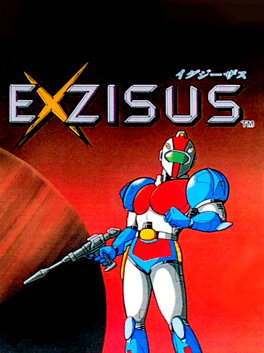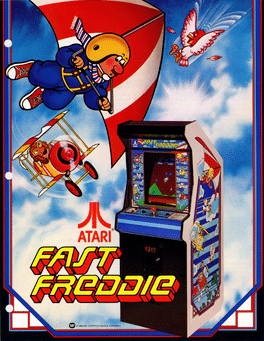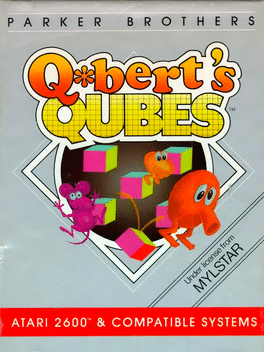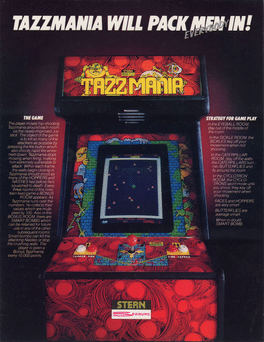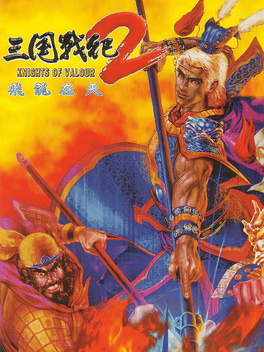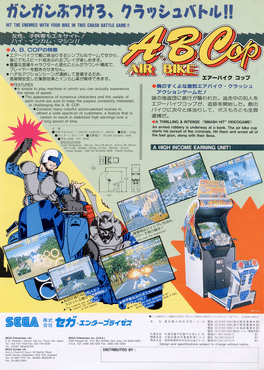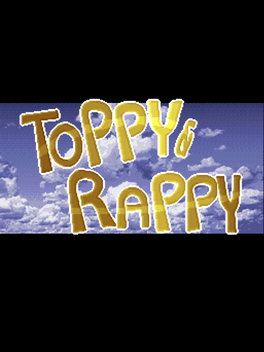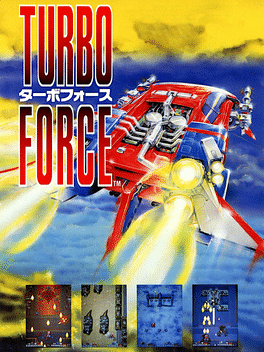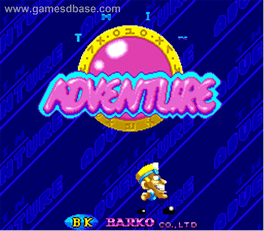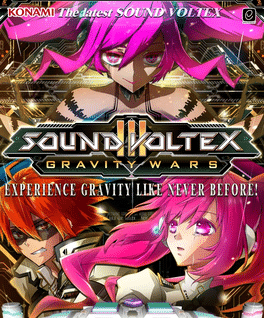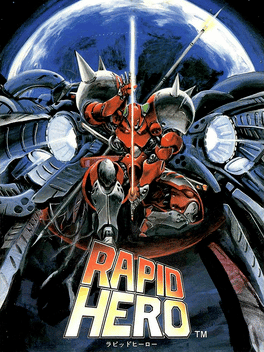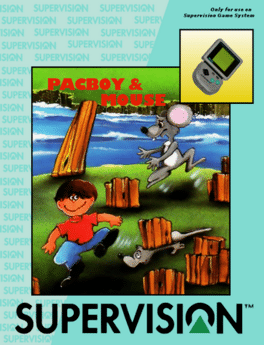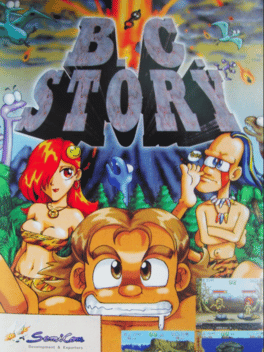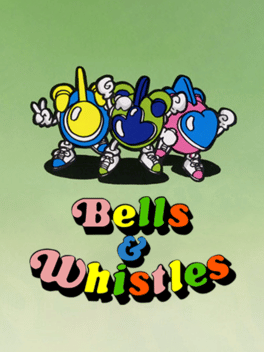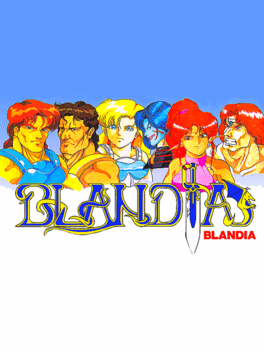Most Popular Arcade Games - Page 120
-
Exc3lsior
1995
Exc3lsior
1995
Excelsior is an adult-themed shooter game with puzzle elements featuring photographic images of nude women. The objective of each stage is to destroy the blocks to reveal the naked woman hidden behind them. At the start of the game the player selects one of three player characters, and then selects one of five girls (and one guy) as the person hidden in the bonus stage. In each regular stage the player uses a powertool to drill away at the blocks obstructing the view of the nude girl underneath. Various enemies appear at regular intervals and must be avoided or destroyed with gunfire or bombs. Occasionally various power-ups appear that the player may collect for more fire-power or drilling power. Once 65% of the obstructing blocks have been destroyed, the background image goes from a dark, shaded image to a bright, full color image. And the level is cleared after 81% of the blocks are cleared. After each stage the player returns to the same bonus stage. Here the player clears a wall of bricks with no enemi -
Extreme Downhill
1995
Extreme Downhill
1995
Extreme Downhill was produced by American Sammy in 1995. American Sammy released 12 different machines in our database under this trade name, starting in 1991. Other machines made by American Sammy during the time period Extreme Downhill was produced include Zombie Raid, Wild West, Coin Circus, Eagle Shot Golf, Krazy Bowl, Simple Simon, and Daioh. -
Exzisus
1987
Exzisus
1987
Exzisus was produced by Taito in 1987. Taito released 403 different machines in our database under this trade name, starting in 1967. Other machines made by Taito during the time period Exzisus was produced include Arkanoid - Revenge Of Doh, Double Dragon, Dr. Toppel Tankentai, Flying Shark, Hishou Same, Great Gurianos, Inspiration Baseball, Tokio, Storming Party, and Soldier Of Light. -
Flyboy
1982
Flyboy
1982
ake off on a fantastic video trip. A voyage that simulates the thrills and skills of actual Hang Gliding. Players use the joystick to control Freddie, but good timing and strategy is necessary to successfully negotiate invisible air currents, wind direction and up and down drafts. This game has incredible visual impact for this time, Freddie flies the skies over the Alps--over trains, trees, bridges, through winter and summer seasons; over the Pacific--over a yacht, tropical islands, an aircraft carrier; and over Egypt--camels, Pyramids, the Taj Mahal, the Sphinx, through day and night landscapes. It's a complete global challenge with non-stop action over a continuously changing panorama below. -
Q*bert's Qubes
1983
Q*bert's Qubes
1983
The game features Q*bert, but introduces new enemies: Meltniks, Soobops, and Rat-A-Tat-Tat. The player navigates the protagonist around a plane of cubes while avoiding enemies. Jumping on a cube causes it to rotate, changing the color of the visible sides of the cube. The goal is to match a line of cubes to a target sample; later levels require multiple rows to match. -
Tazz-Mania
1982
Tazz-Mania
1982
You control a Q*bert-style character with a machine gun. The object of the game is to shoot all the "hoppers" (small non-moving characters) in room and then move onto the next. Each room has its own unique monster type that attacks you and the room is named accordingly. For instance, the first two are: The Face Room - Square face monsters that chase you The Evil Eyeball Room - Eyeball monsters that bounce around The Smart Bomb kills all the monsters currently on-screen and stops the walls that are slowly closing in from the left and the right. Every third screen is a bonus room containing two Smart Bombs and numbers that can be collected in ascending order to gain points. The walls in the bonus rooms close in much faster. Use an eight-direction machine to kill the hoppers. Hold the fire button down for rapid fire, but you will be unable to move while doing so. Bullets have a limited range and also bounce off of the walls. Running into hoppers or monsters will kill you. When all the hoppers are killed the top and b -
Knights of Valour 2
2000
-
Abcop: A.B. Cop
1991
Abcop: A.B. Cop
1991
The player takes on the role of the A.B. (Air Bike) Cop who must chase down and destroy the perpetrators of various crimes (which changes every level) before the time limit expires. A.B Cop introduced an element new to the racing genre: the end-of-level guardian. -
Toppy & Rappy
1996
Toppy & Rappy
1996
Toppy & Rappy can be seen as a sucessor in spirit to Metal Saver, although it seems inferior to the two years older game in many ways. Not only does it run in a lower resolution, but the art style is very inconsistent between sprites and backgrounds as well. Once again one male and one female character are used as protagonists, but this time they have equal abilities and only differ in their looks. Instead of grabbing powerups directly, the two gather money by defeating enemies, which is used to buy weapons and ammunition in a shop between stages. -
Turbo Force
1991
Turbo Force
1991
Turbo Force is even more of a direct predecessor to Sonic Wings than is Rabio Lepus: Turbo Force. The story is that an American Air Force pilot, while racing his car on a public road, wanders into another mysterious dimension and gets caught up in a war there. -
Twin Adventure
1995
Twin Adventure
1995
Guide twin brothers Tom and Sam to rescuing the princess and restoring peace to the Dream Land Paradise by going through various mini-games. -
Sound Voltex III: Gravity Wars
2014
FX and BT notes, both short and long ones, can now overlap. The FX notes have been made thinner as a result. Analog chains can start from anywhere and not just from the extremities of the chart lane anymore. Analog chains can now extend outside of the chart lane as well. New analog effects have also been added. You can now change the colors of the analog chain lines. There are four available colors: Blue, Pink, Green and Yellow. Both analog chain lines can be set to have the same color. EARLY/LATE indicators for timing judgment have been added. They work in the same way as in the beatmania IIDX and DanceDanceRevolution series. At the song result screen, it is possible to see how many EARLY and LATE "NEARs" you have hit. You can now change the Hi-SPEED value more accurately by pressing the START button twice. The maximum Hi-SPEED value has been increased from 6.0 to 7.0. By pressing the 6 button while holding the START button, you can permanently save your desired scrolling speed (the Hi-SPEED x BPM value), which wi -
Bostilda
1990
Bostilda
1990
A.B. Cop is a futuristic 3D racing arcade game released by Sega in 1990.[3] Gameplay is similar to that of Chase H.Q.. The player takes on the role of the A.B. (Air Bike) Cop who must chase down and destroy the perpetrators of various crimes (which changes every level) before the time limit expires. A.B Cop introduced an element new to the racing genre: the end-of-level guardian. -
Rapid Hero
1994
Rapid Hero
1994
International version of Rapid Hero was discovered called Arcadia. Rapid Hero is a very classic and relatively efficient shmup . At the command of a hunter who also thinks somewhat of the design of Strike Gunner STG , you will have to repel the enemy bursts avoiding of course to make you touch ... Two heroes are willing to carry out this mission, with a few minor differences in gameplay: the first aircraft is specialized in concentrated direct fire, the second in the deployed shot. Of course, the game offers you its selection of power-ups and special weapons, such as auxiliary and self-guided lasers. The course of the game is rather neat with a certain sense of staging. The big enemies arrive from afar and see their shadow emerge under a heap of clouds before presenting themselves to you is still very pleasant, as are the enemies coming out of destroyed buildings. Stage 3 is an infiltration into an enemy armada: you will see the long enemy ship scrolling from the beginning of the level, before finding it later in t -
BRap Boy
1992
BRap Boy
1992
B. Rap Boys was produced by Kaneko in 1992. Kaneko released 33 different machines in our database under this trade name, starting in 1982. Other machines made by Kaneko during the time period B. Rap Boys was produced include Bakuretsu Breaker, Nexzr, Fujiyama Buster, Shogun Warriors, Gals Panic II, Berlin Wall, Magical Crystals, Air Buster, Gals Panic, and DJ Boy. Add by Lennux -
B. C. Story
1997
B. C. Story
1997
B.C. Story is a sports arcade game released by SemiCom in 1997. In the game, one can select from caveman characters Sonlo, Milo or Ballo and engage in "B.C" sports events such as running and climbing. -
Bells & Whistles
1991
Bells & Whistles
1991
Detana!! TwinBee is a vertically scrolling shoot 'em up game following the same conventions established in the original TwinBee, where players assume the role of Light and Pastel taking control of TwinBee and WinBee across seven levels to defeat invading forces of the evil alien Iva and save planet Meru. -
Blandia
1992
Blandia
1992
Blandia (ブランディア Burandia?) is a 1992 one-on-one, weapon-based fighting arcade game developed and published by Allumer. It is the sequel to the 1986 arcade game, Gladiator. Along with Strata's Time Killers, Blandia is one of the earliest weapon-based fighting games modeled after its competitor Capcom's 1991 arcade hit Street Fighter II, but later became overshadowed by the success of SNK's 1993 weapon-based fighting game, Samurai Shodown. -
Blue Hawk
1993
-
Knuckle Joe
1985
Knuckle Joe
1985
Knuckle Joe was produced by Seibu Kaihatsu in 1985. Seibu Kaihatsu released 23 different machines in our database under this trade name, starting in 1985. Other machines made by Seibu Kaihatsu during the time period Knuckle Joe was produced include Shot Rider, Wiz, The, Panic Road, Empire City: 1931, and Street Fight.

